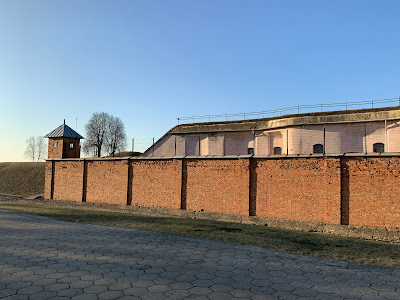On my second day in Vilnius, I head out to Trakai, a small town at the end of a branch line through the woods. The path to my destination leads around the edge of a lake, which, it being -9 degrees C, is completely frozen over. I'm thankful for the thick layer of blubber that I, like a polar bear, very deliberately and intentionally accumulated over the winter.
 |
| Trakai castle. |
Trakai is most notable for its two castles. The more impressive of these was built by Vytautas on an island, and completed in 1409, the year before the battle of Grunwald/Tannenberg. Vytautas himself has as much claim as anyone to be the legendary founder of Lithuania, though he never ruled it independently, but rather as a vassal, at least nominally, of the Polish king Jagiełło. The twist in the tale is that the two were cousins: Jagiełło, born Jogaila, was the son of the Lithuanian Grand Duke Algirdas, and Vytautas the son of his brother Kęstutis. Although not always on good terms, the two managed to put their differences aside long enough to stick it to the Teutonic Knights at Grunwald. The Teutonic connections don't end there: in 1377 the Order besieged an early incarnation of the castle, and in the years before Grunwald – during a period of peace – one of the Order's master masons, Radike, was supposedly involved in supervising the final construction works. Right now, with the lake frozen over, the situation puts me in mind of Alexander Nevsky's 1242 Battle on the Ice, which also didn't end well for the Teutonic Knights.
The castle is approached over a long bridge, which reminds me of the island of Mainau on Lake Constance. Surprisingly, Konstanz, too, features in the history of Lithuania and the Knights: the Council of Konstanz took place shortly after Grunwald, and the Order, trying desperately to rebuild, were active in petitioning Emperor Sigismund for various concessions against Poland-Lithuania. But Sigismund was more interested in resolving the crisis in the papacy, and Jagiełło's kingdom ended up with the better deal. The long overland journey of the Order's delegation from Lithuania to Konstanz must have been similar to mine, though perhaps slower and without quite as much free wifi.
 |
| Inner courtyard of the main tower. |
The castle fell into disrepair in the eighteenth and nineteenth centuries, and was reconstructed in the twentieth. Its collections range from the random-but-elegant (an early glassware collection) to the purely random (a room full of nineteenth-century tobacco pipes), but there are also exhibitions about the castle's history, and two imposing new stained-glass windows depicting Vytautas and his father Kęstutis.
 |
| Vytautas. |
As ever, it's tricky to distinguish between original and reconstruction, between “true facts” and Romantic imaginings, especially on an empty stomach. There's no cafe at the castle, and by the end of my visit I'm undercaffeinated and a little hungry. The latter problem is solvable by virtue of a food van sitting at the town end of the wooden bridge from the castle, selling what I perceive to be Cornish pasties. These, though, are a traditional thing for Karaim/Karaites to eat, one of Lithuania's nationally-recognized ethnic minorities, who've been dwelling in Trakai since before Grunwald. There were Tatars here, too, apparently much-feared mercenaries fighting on the Polish-Lithuanian side, though in the battle itself they ended up not playing much of a role.
 |
| My neighbour Totorių. |
After a little exploration of Trakai town, it's time to head back to Vilnius. I make my way to the Museum of Occupations, housed in the grand, intimidating former KGB building. Not a cheery place, and I'll spare you the details. During World War 2, Lithuania was occupied by the Soviets, then the Germans, then the Soviets again in the space of a few years, with neither side behaving generously towards the locals. And thinking back to the days of Trakai Island Castle and Grunwald, ultimately, the same dynamics are at work: for Lithuania and places like it, independence and prosperity – often even survival – was only to be achieved by playing off distant, powerful entities against each other, whether that be the Teutonic Order and Poland (at the turn of the fifteenth century), the Emperor and the church (at the Council of Konstanz), the Nazis and the Soviets (during the war), and now Brussels (or Washington?) and Moscow.
This last weekend, the three Baltic states ceremonially severed their power grid from that of Russia. After 24 hours of being allowed to stand unaided, like precocious, tottering toddlers, the network was connected to that of the EU: time to hold Daddy's hand again. The official line is that this arrangement drastically reduces the likelihood of malign foreign interference, certainly a concern, again, since February 2022. A. is cautious, though: Russian energy was cheap, and the Baltic governments have been tight-lipped about the costs of this transition and who will bear them.
















